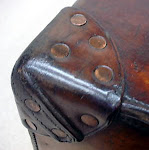Oak bark tanning:
Pre-1940s, tanning was generally carried out using a process that relied on the tannin from oak and other types of bark to preserve the leather. Now, it is believed that we only have one tannery left in the UK that makes oak tanned leather. This means that finding replacement leather which looks and feels right as apart of a restoration project can be very difficult. Chrome tanned leather is rarely an adequate substitute.
A very small number of specialist craftspeople now carry stocks of appropriate leather so make sure you have sourced all your materials before you start to take a piece of work apart for repair.
Take a look at: http://www.barefootleather.co.uk/ as they are repairers and renovation specialists. They stock a range of period leather and linen threads plus rivets and buckles suitable for restoration projects.
Machine stitching
Much of the 1940s leatherwork you will find has been machine stitched. It is often difficult to match this with hand stitched work so you may want to find a repair shop that still uses the old style machines - many machines were made by Singer and Bradbury and for heavy work many leather craftsmen used a range of machines built by British United Shoe Machinery (BUSM); these included the almost indestructible Pilot which can still be found in use today.
Thursday, 11 December 2008
Subscribe to:
Post Comments (Atom)






No comments:
Post a Comment